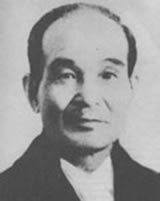Geographically, Okinawa is in close proximity to Taiwan and mainland China, so a lot of trade and cultural exchange took place between those countries. Chinese tradesmen and diplomats often visited Okinawa and brought Chuan-fa, “fist methods” with them.
The modern idea that Karatedo, earlier called Tode, was developed by poor Okinawan farmers, forbidden to posses weapons by the Japanese Satsuma occupation is fanciful. The developers of Tode on Okinawa were mostly Okinawan nobility, many of who traveled to China to learn Chuan-fa, something the local farmers did not have the means to do.
Three basic types of Tode developed in Okinawa: Shuri-te, Naha-te and Tomari-de, named after the geographic locations they developed in. It should be kept in mind, however, that these places are only a stone’s throw from each other, and so these different types of training developed separately because of loyalty to different clans or teachers, more than because of location.
Shuri-te
The foremost exponent of the Shuri-te type of training was Sensei Ankoh Itosu. He was a brilliant teacher and had the largest following in Okinawa. He was responsible for bringing Tode training out of secrecy and one-on-one instruction, into public instruction at the turn of the last century. He accomplished this by teaching at the Okinawan Teacher’s College, so that the school teachers would appreciate its benefits and would help to incorporate Tode instruction into elementary schools, middle schools and high schools throughout Okinawa. Sensei Itosu also encouraged his students to start using the name Karatedo instead of the ancient name Tode. Students of Sensei Itosu went on to found many systems of Karatedo including Shorin-ryu, Shotokan, Shito-ryu, etc.
Naha-te
The foremost exponent of the Naha-te type of training was Sensei Kanryo Higaonna. He originally studied with Seisho Aragaki, in the Naha district of Okinawa. In 1877 he travel to mainland China and studied for about three years (some say longer) with Wei Shin Zan and Liu Liu Ko. Sensei Higaonna’s most famous student, Chojun Miyagi Sensei, went on to found the Goju-ryu system of Karatedo.
Tomari-de
Tomari-de was taught mostly by Aragaki Sensei and Azato Sensei. It may be an over-simplification to say it, but Tomari-de was primarily a combination of the light and airy Shuri-te and the short and powerful Naha-te types of training. Tomari was a sea port district, so Tode practitioners there came into contact with many Chinese merchants, learned many types of Chinese Chuan-fa from them, and so contributed many kinds of kata to Okinawan Tode.
Shuri-te, Naha-te and Tomari-de were all effective types of training and each had its advantages. They have borrowed from each other down through the years, although they have keep distinct differences in appearance and training methods.
Daishihan Kanken Toyama (1888-1966)
Kanken Toyama was born on September 24th in the 21st year of the Meiji era (1888) in Shuri, Okinawa. He was born to a noble family and was consequently raised studying the Chinese classics, which he would later teach in China.
Young Toyama started Tode instruction in 1897 at the age nine, with master Itarashiki, who recognized his potential and suggested that he also study with Itosu Anko, the foremost teacher of the Shuri-te type of Tode. Master Itosu was Kanken Toyama’s main teacher from that day forward. Itosu, however, recommended that young Toyama round out his study of Tode by training with all the other Tode masters of the day. Toyama also studied extensively with Sensei Higaonna Kanryo of the Naha-te, Aragaki Anko Sensei of the Tomari-de, Chibana Sensei, and with weapons masters Oshiro and Tana. Toyama assisted Sensei Itosu from 1907 onward at the Okinawa Teacher’s College in Shuri City.

Daishihan Kanken Toyama
Sensei Itosu developed many proficient students. Some of them became the founders of their own systems of Karatedo, both in Okinawa and Japan, and some became quit famous. However, Sensei Itosu’s three top students were Sensei Hanashiro Chomo, Sensei Kanken Toyama and Sensei Tokuda Anbun. They were all given the formal title of “Shihandai” (top assistant or protégé) by Sensei Itosu. Sensei Hanashiro and Sensei Tokuma died in 1945. It was Sensei Toyama who taught most of the classes for Itosu at the Okinawa Teacher’s College from 1907 onward.
From 1914 onward, Toyama held a high office at the Shuri First Elementary School (Shuri Dai-ichi Shogakku) and taught Karatedo there as well.
Kanken Toyama in China
Sensei Itosu died on January 26, 1915. Sensei Higaonna died in 1916. Sensei Aragaki died in 1918. All of Toyama’s other teachers had also passed away by 1918. From 1915 to 1924, Toyama continued to teach Itosu’s Karatedo at the Okinawan Teachers College and at the Shuri First Elementary School. Many of Itosu Sensei’s advanced students continued to train with Toyama during this time.
In 1924, Toyama accepted a teaching position at a Middle School in Taipei, Taiwan and moved there with his family, where he taught the Chinese classics. While in Taiwan Sensei Toyama studied with masters Chen Fong Tai in Taipei and Lim Tun Tong in Taichung. He learned four styles of Taiwan Chuan-fa (kenpo or fist methods) and Chugoku Chuan-fa (mainland China’s fist methods); Taku, Makaitan, Rudaobai, and Ubo.
Note:
These are the Okinawan pronunciations of his Chinese teacher’s names and their styles of training. Taku is also called Hakuda in Japanese.
Sensei Toyama lived in Taiwan from 1924 to 1930. He then moved to Tokyo, Japan and open a private dojo (training hall) there.
